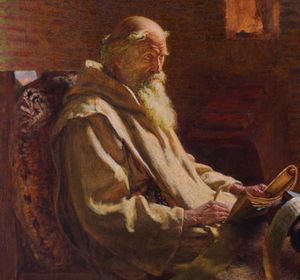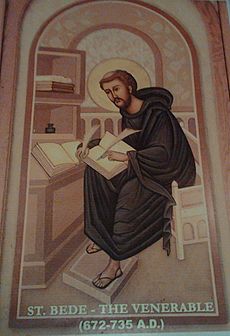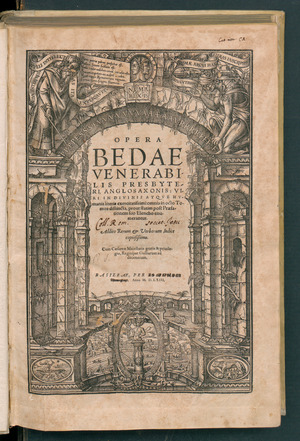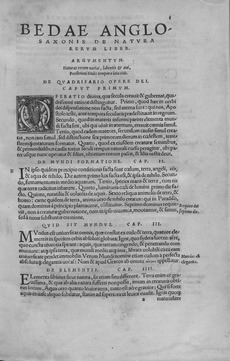Bede facts for kids
Quick facts for kids SaintBede the Venerable |
|
|---|---|

Cropped portrait from The Last Chapter by J. Doyle Penrose (c. 1902), showing Bede finishing his translation of the Gospel of John on his deathbed
|
|
| Doctor of the Church, monk, historian | |
| Born | c. 673 Kingdom of Northumbria, possibly Jarrow in present-day Tyne and Wear, England |
| Died | 26 May 735 (aged 61 or 62) Jarrow, Northumbria |
| Venerated in | Roman Catholic Church, Eastern Orthodox Church, Anglican Communion, and Lutheranism |
| Canonized | Declared a Doctor of the Church in 1899 by Pope Leo XIII, Rome |
| Major shrine | Durham Cathedral, England |
| Feast |
|
| Attributes | Holding the Historia ecclesiastica gentis Anglorum, a quill, a biretta |
| Patronage | English writers and historians; Jarrow, Tyne and Wear, England, Beda College, San Beda University, San Beda College Alabang |
| Influences | |
Bede (pronounced BEED), also known as Saint Bede or The Venerable Bede, was an English monk who lived from about 672 or 673 to 735. He spent most of his life in a monastery in Northumbria, which is now part of England. This monastery was made up of two parts: St Peter at Monkwearmouth and St Paul at Jarrow.
Bede was a very important writer, teacher, and scholar. His most famous book, Ecclesiastical History of the English People, earned him the nickname "The Father of English History." He wrote many books about the Bible and other religious topics. He also studied computus, which was the science of calculating calendar dates, especially for Easter. Bede helped make the system of dating years from the birth of Christ (called Anno Domini, meaning "in the year of our Lord") popular in Europe.
Many historians believe Bede was the most important scholar of his time, especially during the Early Middle Ages. In 1899, Pope Leo XIII officially recognized his importance by declaring him a Doctor of the Church. He is the only person born in Great Britain to receive this special title. Bede was also skilled in languages like Latin and Greek, making old Christian writings easier for his fellow Anglo-Saxons to understand.
Life of Bede
Most of what we know about Bede's life comes from the last chapter of his own book, Ecclesiastical History of the English People. He finished this book around 731, and he mentioned he was about 59 years old then. This means he was born in 672 or 673.
Bede was born on land that belonged to the Monkwearmouth and Jarrow monasteries. When he was seven years old, his family sent him to Monkwearmouth to be educated. Later, he moved to Jarrow with Abbot Ceolfrith. In 686, a terrible plague hit Jarrow. Only two monks were left to sing the church services: Abbot Ceolfrith and a young boy, who was almost certainly Bede. They managed to keep the services going until more monks could be trained.
When Bede was about 19, around 692, he became a deacon. This was earlier than the usual age of 25, which shows how talented he was. Around 702, when he was about 30, he became a priest.
Bede started writing his first books around 701. These were about grammar and were meant for teaching. He continued writing throughout his life, completing over 60 books. His last known work was a letter written in 734 to one of his former students, Ecgbert. Bede was also a teacher and enjoyed music. He was said to be a good singer and could recite poetry.

In 708, some monks accused Bede of having wrong ideas in his book De Temporibus. He had calculated the age of the world differently from what was commonly accepted. Bede defended his calculations in a letter, explaining his reasoning.
Bede traveled to York in 733 to visit Ecgbert, who was then the bishop. He also visited the monastery of Lindisfarne and corresponded with many people across the British Isles. However, it seems he never visited Rome. Most of his life was spent in prayer, following monastic rules, and studying the Bible. He was known as the most learned man of his time.

Bede died on 26 May 735, singing a hymn. He was buried at Jarrow. His student, Cuthbert, wrote a letter describing Bede's last days. Cuthbert said Bede was ill with breathing problems but continued to dictate his work until the very end. Just before he died, he asked for his few treasures—some pepper, napkins, and incense—to be given to the monastery's priests. He dictated one last sentence and then passed away.
A short poem in Old English, known as "Bede's Death Song", is often said to have been composed by Bede on his deathbed. His remains were later moved to Durham Cathedral in the 11th century.
Bede's Writings
Bede wrote many different kinds of books, including scientific, historical, and religious works. He knew a lot about ancient writers and early Christian thinkers. He even knew some Greek. While today he is mostly known as a historian, his books on grammar, timekeeping, and Bible studies were also very important in his time.
Ecclesiastical History of the English People

Bede's most famous book is An Ecclesiastical History of the English People, finished around 731. This book tells the story of the Christian church in England.
The book starts with a little bit about England's geography. Then it goes back to Julius Caesar's invasion in 55 BC. It talks about how Christianity first came to Roman Britain and the story of Saint Alban, an early Christian martyr. The book then focuses on Augustine of Canterbury's mission in 597, which brought Christianity to the Anglo-Saxons.
Bede's history continues, describing the spread of Christianity in different parts of England. It tells about kings like Edwin of Northumbria, Oswald of Northumbria, and Oswiu, who helped Christianity grow. A key event in the book is the Synod of Whitby in 664. This meeting decided how to calculate the date of Easter, which was a big step towards uniting the church in England.
Bede wrote this book to show how the Christian church in England became united. He wanted to teach readers by giving examples of good spiritual behavior. He also included interesting stories about places and people to make the book enjoyable.
How Bede Wrote His History
Bede had access to an excellent library at his monastery. It had about 200 books, collected by his abbots. He used many older writings as his sources. These included histories by Christian writers like Eusebius and Orosius. He also used works by pagan historians.
For information about more recent events, Bede relied on other books written by monks. He also got a lot of information from people he corresponded with. For example, a monk named Albinus from Canterbury gave him details about the church in Kent. Another priest, Nothhelm, helped him get copies of letters from Rome about Augustine's mission. Bede was careful to mention his sources in his book.
Bede's writing style was clear and easy to read, even though he used complex Latin. He is considered one of the best Latin writers from the Anglo-Saxon period.
Bede's Goals and Views
Bede's main goal was to show how the Christian church in England grew and became united. He was not happy that the native Britons, who were already Christian, did not help convert the Anglo-Saxons. By the end of his book, the English church is shown as strong and dominant.
Bede also wanted to teach moral lessons through his history. He included stories about miracles because he believed they showed God's work and could help people's faith.
Bede was from Northumbria, so his book sometimes focused more on events in his own region. He didn't always give as much detail about other kingdoms like Mercia or Wessex.
Dating with Anno Domini
When Bede wrote his history, people used different ways to date events. One common way was to count in 15-year cycles called indictions. Another was to use the regnal years of kings or emperors.
Bede used a different method as his main way of dating: the Anno Domini (AD) system. This system counts years from the birth of Christ. While Bede didn't invent this method, his use of it in his Ecclesiastical History and other works helped it become widely used throughout Europe.
What Historians Think Today
Bede's Ecclesiastical History was copied many times during the Middle Ages. About 160 copies still exist today. It was first printed between 1474 and 1482.
Modern historians praise Bede's work very highly. They see it as a groundbreaking achievement. He was able to gather information from many different sources and put it together into a clear, organized history. Many call him the "first and greatest of England's historians."
Bede's work was very influential. Later medieval writers used his books as sources and inspiration. Even during the religious conflicts of early modern Europe, both Protestants and Catholics used his Historia.
Other Important Works
Bede wrote many other important books besides his famous history.
Chronicles
In 725, Bede wrote a longer history called the Greater Chronicle. This book sometimes circulated on its own. For recent events, it used sources like the Liber Pontificalis (a book about popes). For older events, he used Eusebius's Chronikoi Kanones.
Lives of Saints
Bede also wrote biographies of important religious figures. These included lives of the abbots of his own monasteries (Wearmouth and Jarrow). He also wrote both a poem and a prose version of the life of St Cuthbert. He adapted the life of Saint Felix and translated the story of St Anastasius. He also created a list of saints called the Martyrology.
Religious Writings
In his own time, Bede was most famous for his books explaining the Bible and other religious topics. Most of his writings were of this type. He wrote about both the Old and New Testaments. It was for these religious writings that he was declared a saint and given the title Doctor Anglorum (Teacher of the English).
Bede studied the Bible very deeply. He also read many books by earlier Christian thinkers, known as the Church Fathers. He learned Greek and tried to learn Hebrew to better understand these texts. He wanted to explain the ideas of the Church Fathers to his students and readers.
He also wrote homilies, which are sermons or talks used in church services. These explained religious ideas for important Christian times like Advent, Lent, and Easter. His religious works were widely read throughout the Middle Ages.
Time and Astronomy
Bede was very interested in time and the natural world. Around 703, he wrote De temporibus (On Time), which explained how to calculate the date of Easter. He also included a timeline of the world.
Around 723, he wrote a longer and more important book called On the Reckoning of Time. This book was very influential for centuries. It explained how the spherical Earth affects the length of daylight and how the Sun and Moon influence the seasons and the new moon. Bede also wrote about how the Moon affects the tides. He showed that tides happen twice a day because of the Moon and that spring and neap tides are also linked to the Moon's position.
For his calculations, Bede made a new estimate for the age of the world since creation, dating it to 3952 BC. Some people disagreed with his new calculations, but he defended his work.
Bede also wrote On the Nature of Things, which was about the natural world. His writings were so important that a monk in Switzerland later said that God made Bede "rise from the West as a new Sun to illuminate the whole Earth."
Educational Books
Bede wrote books to help teach grammar in the monastery school. One was De arte metrica, which taught how to write Latin poetry. It used examples from Christian poets. This book became a standard textbook for teaching Latin poetry for hundreds of years.
He also wrote De orthographia, a book about spelling and grammar, which helped readers understand older Latin texts. These books showed Bede's dedication to education and helping others learn.
Poetry
Bede also wrote poetry in Latin. These included poems about the Day of Judgment and a poetic life of St Cuthbert. He also wrote collections of hymns and other religious poems.
According to his student Cuthbert, Bede was "learned in our songs," meaning he knew English poetry. Cuthbert's letter about Bede's death mentions a five-line poem in Old English, known as "Bede's Death Song", that Bede may have composed on his deathbed.
Honoring Bede

At first, Bede was not widely honored in England because he died on the same day as Augustine of Canterbury. However, he was honored outside England, thanks to the efforts of Saint Boniface and Alcuin. They helped spread Bede's religious writings and praised him as a role model for monks.
Bede's importance grew in England during the 10th century. By the 14th century, many cathedrals honored him. His body was moved from Jarrow to Durham Cathedral around 1020. In 1370, his remains were moved to a special shrine in the Galilee Chapel at Durham Cathedral. Although the shrine was destroyed during the English Reformation, his bones were reburied in the chapel.
In 1899, the Vatican officially recognized his great scholarship and importance to Catholicism by declaring him a Doctor of the Church. He is the only Englishman to receive this special title. His feast day is celebrated on May 25th in the Catholic Church and the Church of England, and on May 27th in the Eastern Orthodox Church.
Bede became known as Venerable Bede (Latin: Beda Venerabilis) by the 9th century because of his holiness. This title means "worthy of respect" or "honorable." A legend says that an angel miraculously added the word "venerabilis" to his unfinished tomb inscription.
Bede's Legacy Today
Bede's reputation as a historian, especially because of his Historia Ecclesiastica, remains very strong. Many historians consider him one of the most important early historians of Christian Europe.
Jarrow Hall (formerly Bede's World) in Jarrow is a museum that celebrates Bede's life and work. The Bede Metro station in Tyne and Wear is also named after him.
Images for kids
-
A page from a copy of Bede's Lives of St Cuthbert, showing King Æthelstan presenting the work to the saint. This manuscript was given to St Cuthbert's shrine in 934.
See also
 In Spanish: Beda para niños
In Spanish: Beda para niños
- List of manuscripts of Bede's Historia Ecclesiastica
- List of works by Bede
- Medieval ecclesiastic historiography





